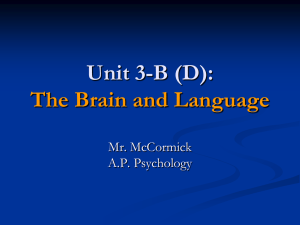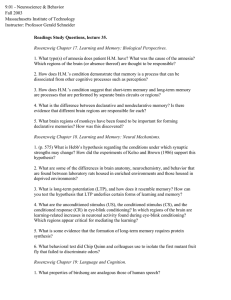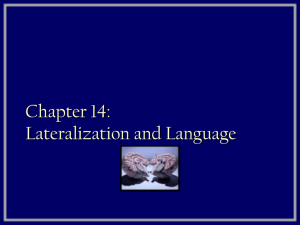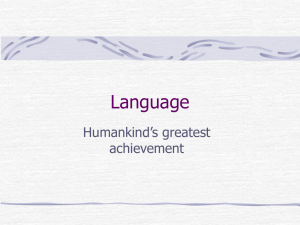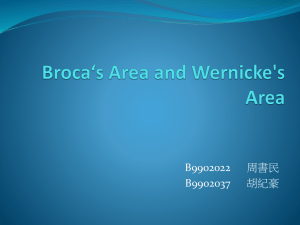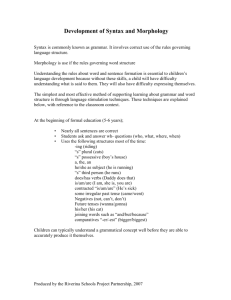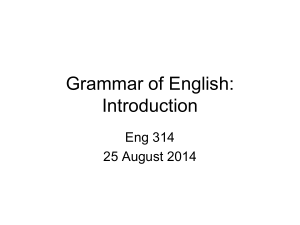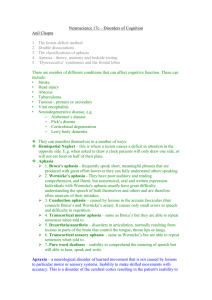Document 13670981
advertisement
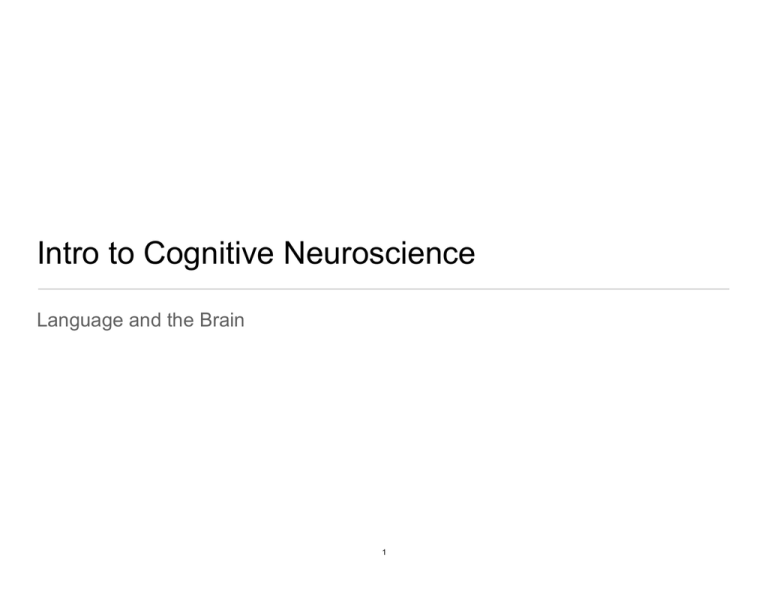
Intro to Cognitive Neuroscience Language and the Brain 1 Language - levels of analysis. • Discourse level - extracting meaning from a coherent group of sentences. • Syntactic level - relationships between types of words in a sentence (nouns, verbs, etc). • Word level - words! • Morpheme level - morphemes are the smallest units that carry meaning. • Phoneme level - smallest distinguishable units of sound. 2 When language processing breaks • Paul Broca, 1851, Paris • Patient who could not speak, but displayed normal intelligence and comprehension. • M. Leborgne had a large lesion in his left frontal lobes (discovered after his death). • Aphasia - inability to speak in individuals “who are neither paralyzed nor idiots” • Modern: Broca’s aphasia is most characterized by difficulties with syntax. 3 Image courtesy of the U.S. Federal Government. When language processing breaks • Broca’s aphasia - modern example (from Howard Gardner) •Were you in the Coast Guard? •No, er, yes, yes, . . . ship . . . Massachu . . . chusetts . . . Coastguard . . . years. (He raised his hands twice, indicating the number “nineteen.”) •Why are you in the hospital? •(Pointing to his paralyzed arm) Arm no good, (then to his mouth) Speech . . can’t say . . . talk, you see. •Could you tell me what you’ve been doing in the hospital? •Yes, sure. Me go er, uh, P. t. nine o’cot, speech . . . two times . . . read . . . wr . . . ripe, er, rike, er, write . . . practice . . . get-ting better. 4 When language processing breaks • Carl Wernicke, 1874, Breslau. • Described a different aphasia - patients spoke very fluently, but words were wrong, or nonwords, and made no sense. • Brain lesion associated with this aphasia was in the left temporal lobe. • Wernicke theorized that these were two speech areas with different specializations one for sensory information and one for motor information. 5 Image courtesy of the U.S. Federal Government. When language processing breaks • Wernicke’s aphasia - modern example (from Howard Gardner) •What brings you to the hospital? •Boy, I’m sweating, I’m awful nervous, you know, once in a while I get caught up, I can’t mention the tarripoi, a month ago, quite a little, I’ve done a lot well, I impose a lot, while, on the other hand, you know what I mean, I have to run around, look it over, trebbin and all that sort of stuff. •Thank you. I want to ask you a few •Oh, sure, go ahead, any old thing you want. If I could I would. Oh I’m taking the word the wrong way to say, all of the barbers here whenever they stop you it’s going around and around, if you know what I mean, that is tying and trying for repucer, repuceration, well we were trying the best that we could while another time it was the over there the same thing. . . 6 When language processing breaks • Claims of functional specialization (modularity) in the brain went out of fashion in early 1900s. • Wernicke’s descriptions of the two centers did not explain all symptoms of aphasia sufferers. • Few cases fit neatly into categories. • Anatomical evidence was sometimes shaky. 7 When language processing breaks • Mid-twentieth-century, modularity comes back “in.” • New cases, patients with production or comprehension deficits for particular categories. • Abstract vs. concrete words, but also colours, proper names, body parts, foods, animals, objects, actions, shapes, etc. 8 Patients with precise deficits • How is lexical information stored in the brain? • Meanings are represented by combinations of perceptual and functional information. • When patients’ ability for certain types of information (ie, color) is decreased, then they can no longer connect the word “apple” to its meaning information. Image courtesy of the U.S. Department of Agriculture. 9 Language comprehension • McGurk effect - top-down processes affect perception http://www.youtube.com/watch?v=jtsfidRq2tw&feature=related 10 Language comprehension • “I shot an elephant in my pajamas. What he was doing in my pajamas, I don’t know.” -Groucho Marx • Garden path sentences have structural ambiguity. • Two hypotheses: • Parser hypothesis - syntactic structure is chosen from available information and checked against meaning later. • Ambiguity-resolution hypothesis - bottom-up and top-down processes interact in a “guessing game” and structures that are most activated win. 11 Language acquisition • This language thing is really complicated. How do we learn to do it? • Until 1950’s, everyone thought that learning language was like learning anything else. • Variety of languages with different structures. • Children will learn whatever language they are exposed to. • Children not exposed to language don’t have any. 12 Language acquisition • Noam Chomsky, 1950s • Noticed two things: • Speakers of any language can produce an effectively infinite number of sentences. • Little kids rapidly develop the ability to comprehend and produce sentences they have never heard before. • Proposed that the “poverty of the input” was too great to account for these abilities, and humans must be, in some way, “wired” to acquire language from the input available. 13 Language acquisition • Chomsky proposed that speakers of a language know both its vocabulary and its generative grammar - rules that say how you can put words together. • Kids must learn both, and do. • Not just learning each case - little kids say things like “We goed to the store,” and “I want to have a ball if Johnny haves a ball.” 14 Language acquisition • Chomsky proposes that there is some universal grammar, a set of limits on what sorts of grammars languages can have. • Child learning language can use available input to categorize the language into one of these grammars. • But languages have lots of rules! How can this be genetically coded? 15 Hawaii and universal grammar • If universal grammar gives kids’ brains a structure into which to fit the available input, what happens when the available input doesn’t have a consistent grammar? • Hawaii, turn of the 20th century. • Very mixed pool of immigrants, developed a common pidgin for communicating. 16 Hawaii and universal grammar • What happens when kids grow up in a polyglot community where the common language is a pidgin? • Take pidgin vocabulary, expand it, develop more sophisticated syntax. • These much-more-sophisticated languages that develop are called creoles. 17 Hawaii and Universal Grammar • Where does this syntax come from? • Children’s parents languages? But many differences between creole syntax and any of the potential donor languages. • Bickerton argues that syntax comes from kids’ innate linguistic abilities; ie, these are the “default” settings for the grammar switches. 18 MIT OpenCourseWare http://ocw.mit.edu Introduction to Cognitive Neuroscience Summer 2008 For information about citing these materials or our Terms of Use, visit: http://ocw.mit.edu/terms.
